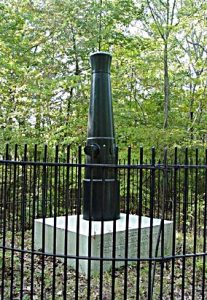By Noel Harrison, NPS
A longtime area resident, Noel Harrison is Manager of Easements for the Fredericksburg office of the National Park Service.
To the almost-forgotten past belongs the story of Fredericksburg’s “Battlefield granite” quarries, once touted as being among “the most valuable granite properties in the United States.”
The term, “Battlefield granite” is a trade name for a granitoid rock that was extracted from what today is called the Fredericksburg Complex, a group of geological rock units. Technically, the Fredericksburg Complex is a group of metamorphosed rocks, which include gneisses, schists, and granites (Pavlides, 1980). Blue-gray biotite granites with several joint sets (fractures) were extensively quarried for building and monumental stone (Watson, 1907). The color of the granite comes from the combination of minute flakes of black biotite mica scattered throughout a gray-white feldspar background. Exposed dikes and sills of granite are generally less than 200 feet thick. In some places, they are transected by pegmatite dikes (feldspar) up to two inches thick (Steidtmann, 1945).
Stone from the south bank of the Rappahannock River was quarried at six sites west of Fredericksburg. These quarries were worked intermittently during the late 1800s and the early 1900s.
The qualities of the “Battlefield granite" probably first became known with the establishment of a canal and navigation system (Callahan, 1969) along the Rappahannock River west of Fredericksburg. Beginning in 1829, a route was dug through what would later become the quarry vicinity, and the usefulness of the loose rock for building purposes was demonstrated during the subsequent construction of the stone canal locks (Figure 1).
The first real attempt at quarrying came in 1871 when George Hazewell leased property along the Rappahannock River 2.5 miles northwest of the city with the intention of excavating granite for architectural stone. A quarry was apparently opened but later closed because of the difficulty of moving massive granite blocks over muddy roads to Fredericksburg’s Rappahannock River wharves to the Richmond, Fredericksburg, and Potomac Railroad depot.
In October 1893, Joseph York, an entrepreneur from New Jersey, announced that he would lease the quarry property for a period of 25 years. York was convinced that his preliminary survey of the area had revealed “one of the most valuable granite properties in the United States” (Free Lance, 1893). Shortly after signing the lease, York formed a quarrying partnership with Joseph Swift, a businessman from Delaware, as the Battlefield Granite Company (Fredericksburg b). The partners soon became engaged in the most extensive activity yet carried out at the quarry site. A rising demand for Virginia granite made hauling wagonloads of stone over muddy roads financially practical. The partners employed about 40 workmen, who extracted granite, transported it to a stone-cutting yard in the City of Fredericksburg, and there, crafted rough stone into finished products of various types. Their operation provided granite for buildings in Petersburg and Williamsburg, and cemeteries in Washington, D.C. and Fredericksburg.
Unfortunately, the operation began to experience a variety of problems. In 1894 York and Swift lost in their bid to obtain an important street-paving contract from the Fredericksburg City Council. Although the partners reported a business upswing in late 1896, their fortunes plummeted when a fire destroyed much of the stonecutting yard (Daily Star, 1896).
Between January 1897 and April 1899 the quarries underwent a change in management and eventually York and Swift transferred control of operations to the partnership of E.J. Cartright and J.H. Davis, and the Battlefield Granite Company went out of existence.
The most important change made by Cartright and Davis alleviated the transportation problem. In May 1901, they acquired the right to float stone from the quarries to the stonecutting yard, using part of the old Fredericksburg canal system. In exchange, the partners pledged to repair any damage incurred to the canal’s locks and banks and to pay rent based on the amount of stone they transported. In addition to being an alternative to moving tons of granite over bad roads, this arrangement would be the last regular use of the canal network for transportation purposes.
The Cartright and Davis years were indeed the heyday of Fredericksburg’s granite industry. Elaborate processes were used to extract, transport, and process the granite. By 1906, there were six quarries operating at the same riverside site that had first attracted George Hazewell’s attention back in 1871 (Watson, 1907).
A typical journey for a piece of Battlefield granite began at one of the quarries. Cartright and Davis employees used both hand and steam drills to bore holes in to the granite (Figure 2). Rough pieces of granite were subsequently broken off from a quarry face by placing round wedges or dynamite into the holes. A steam hoist was used in the loading of heavy stone blocks at the quarries. The loose rock was transported to the Rappahannock River and dumped into a canal scow. The documented presence of “hand cars” at the quarrying area in 1914 indicates that a miniature railway may also have been utilized to help move granite to the waiting scow (Fredericksburg c).
The scow was then floated down the river to a dam situated between the quarries and the city where the boat was lowered into the Fredericksburg canal system by using a lock constructed with blocks of granite. After leaving the lock, the scow passed down the canal to a pier located at the edge of the stoneyard. Derricks were used to unload the granite, which was then taken to a barn-like finishing shed. A miniature “railway” enabled workmen to push heavy blocks of granite around the stoneyard and into the shed using dollies with flanged wheels (Raymond Decater, 1985; personal communication). In addition to providing shelter for workmen and their tools, the shed housed an office, a stable, and a blacksmith shop (Fredericksburg d).
The granite could now be fashioned into a variety of forms. If the stone was destined to become curbs, cobbles/spalls, or other “rough” materials, it was shaped using chisels, special hammers and saws. If more delicate forms were desired, such as tombstones and monuments, granite cutters went to work with grinders, polishing machines, hand drills, and lettering tools. Waste granite and other types of “rubble” could be pulverized in a crusher for local use.
Like all craftsmen, the granite cutters had their own special vocabulary. A piece of granite arriving from the quarry was said to be in the form of a “pattern” which was the approximate size and shape the stone needed for the project construction. A “good pattern” required a minimal amount of additional labor to achieve a shape of the desired size. A “bad pattern” called for an extensive amount of labor. In processing, or “finishing,” a rectilinear “pattern,” the cutter would begin by preparing four smooth edges, or “drafts,” around the periphery of one surface of the stone. This determined the plane to which the rough area remained between the “drafts” was subsequently reduced. The cutter would “finish” each of the six surfaces of his “pattern” in this manner, utilizing a square to make sure the surface he was working on was perpendicular to those surfaces he had already completed (McKee, 1973).
Much of the company’s work involved providing street improvements to the City of Fredericksburg. At the work site, Cartright and Davis employees would grade a street using plows and lay terra-cotta drainage pipes where necessary. Granite spalls, or cobblestones, and curbs were then installed on the leveled surface. Finally, bricks were laid and concrete sidewalks poured to give the street a “finished” appearance.
Additional income came from the crafting of “graveyard architecture.” The engineering works included in this category range from a simple tombstone made for a Northumberland County family to a mausoleum that was built by Cartright and Davis in a cemetery near the Town of Orange (Figure 3). One businessman from Pennsylvania was so impressed by the qualities of “Battlefield granite,” that he purchased an entire railroad carload of blank tombstones and had it shipped to his home town.
Cartright and Davis provided veterans’ groups with battlefield monuments commemorating the various actions of the Civil War. One of the most ambitious projects undertaken involved the construction of a monument honoring General Alexander Hays who was killed during the Battle of the Wilderness. Survivors of the war who had served under him wanted to mark the site of his fatal wounding by having a large cannon barrel erected. Cartright and Davis accordingly supplied a six-ton granite base to which the five-ton cannon was affixed (Figure 4). This was one of the largest single stones ever marketed by the quarrymen (Daily Star, 1905).
In 1904, Battlefield Granite was used in the construction of a house for E.J. Cartright. This building, located on Fredericksburg’s prestigious Washington Avenue, was finished in 1905 (Figure 5). The mansion’s gray stone walls and “haunted house” design represented the most elaborate utilization of Cartright and Davis granite.
After 1905 the firm of Cartright and Davis went into a decline. The quarries were closed down in 1907. Operations resumed in 1908, but business was not what it used to be. On October 4, 1912 Cartright turned over all his interests in the firm to Davis and the partnership was dissolved (Fredericksburg e). In August 1914, the two men joined forces again as “Cartright and Davis, Incorporated.” Four months later this designation was discarded in favor of “Battlefield Granite Corporation” (Fredericksburg f).
Like the Battlefield Granite Company of 1895, the Battlefield Granite Corporation of 1914 had plenty of optimism but not enough business. On June 30, 1919, the property of the Battlefield Granite Corporation was sold. The quarry was used by other businessmen until 1945 and the stoneyard to 1923.
In 1956, the Culpeper Stone Company leased the quarries area from its long-time owners, the Taylor family. This time, “Battlefield granite” was to be utilized as crushed stone for construction projects. During a flurry of activity in 1958-1959, one of the quarries yielded up to 150 tons of granite per hour (Gooch, 1960).
REFERENCES
Callahan, Donald B., 1969, The Rappahannock Canal: Fredericksburg, Virginia, Robert A. Hodge, p. 28-34.
Daily Star, 1896, December 5, Fredericksburg, Virginia.
__________, 1905, April 1, Fredericksburg, Virginia.
Fredericksburg a, Deed Book AE, p. 387.
__________ b, Deed Book AF, p. 90.
__________ c. 1903, Land Book, p. 9.
__________ d, Deed Book 48, p. 357.
__________ e. Records of City Council, V. 16, p. 221, 251, 352, 369, 380.
__________ f. Records of City Council, V. 17, p. 51, 251, 443.
Free Lance, 1893, October 13, 31, Fredericksburg, Virginia.
Gooch, Edwin O., Parrott, W.T., and Wood, R.S., 1960, Sources of Aggregate Used in Virginia Highway Construction: Virginia Division of Mineral Resources. Mineral Resources Report 1, 65 p.
McKee, H.J., 1973, Introduction to Early American Masonry: Stone, Brick, Mortar, and Plaster: Washington, D.C. Columbia Univ., p. 21
Pavlides, Louis, 1980, Revised Nomenclature and Stratigraphic Relationships of the Fredericksburg Complex and Quantico Formation of the Virginia Piedmont: U.S. Geol. Survey Prof. Paper 1146, 29p.
Steidtmann, Edward, 1945, Commercial Granites and Other Crystalline Rocks of Virginia: Virginia Geol. Survey Bull. 64, p. 40-43.
Watson, T.L. 1907, Mineral Resources of Virginia: Lynchburg, Virginia, Virginia Jamestown Exposition Commission, p. 27-28.
This article originally appeared in Virginia Minerals, a publication of the Virginia Division of Mineral Resources. It is reprinted online with the author’s permission. Its print citation follows:
Harrison, Noel. "Fredericksburg's Battlefield Granite." Virginia Minerals, Volume 32, No. 3, 1986, pp. 27-30.




